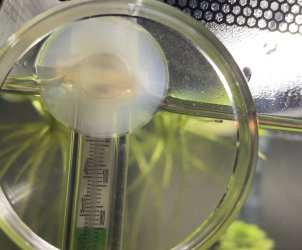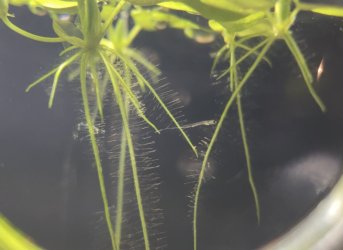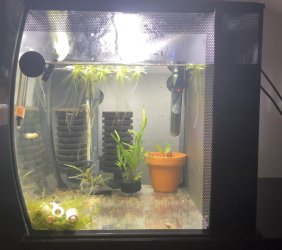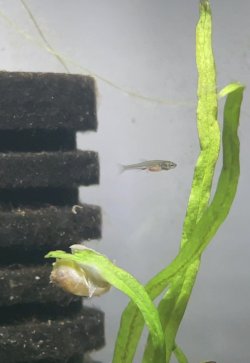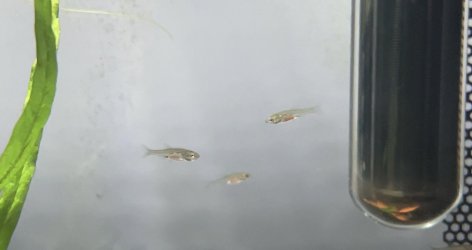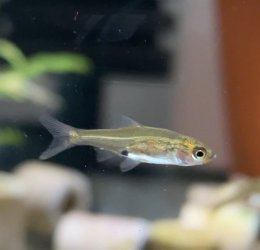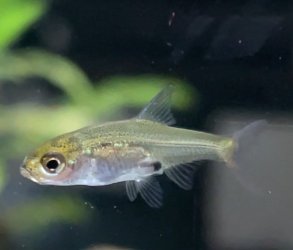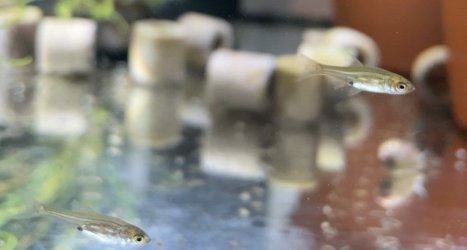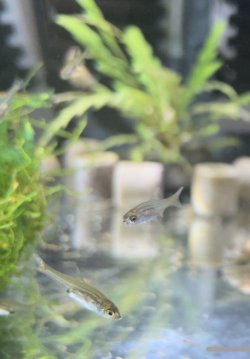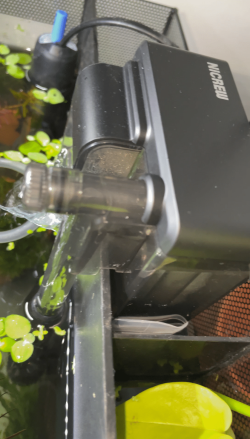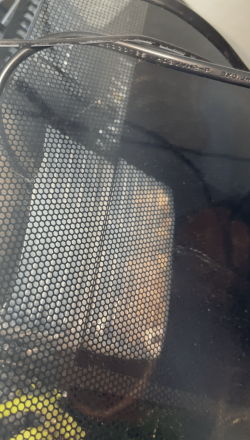🌟 Exclusive Amazon Black Friday Deals 2024 🌟
Don’t miss out on the best deals of the season! Shop now 🎁
You are using an out of date browser. It may not display this or other websites correctly.
You should upgrade or use an alternative browser.
You should upgrade or use an alternative browser.
Attempting to Breed Sawbwa resplendens (Rummynose Rasbora)
Nothing for you to worry about, though they may get made fun of if they go to school doing that.
Update - Fry are growing slowly but surely! An average size of 1.5cm long with a diet of infusoria + mixture of dry foods crushed in mortar and pestle
such as Hikari vibra bites, algae wafers, generic flake foods etc etc dosed with JBL Atvitol. Weekly 10-30% water changes. I removed the Myriophyllum mattogrossense in the pot and replaced it with a baby Cryptocoryne undulatus (from main tank) + a Hygrophila pinnatifida glued to a pebble. Introduced bladder snails as a clean-up crew as algae started to occur with build-ups of mulm also. Overall not many issues and the fish are doing really well
such as Hikari vibra bites, algae wafers, generic flake foods etc etc dosed with JBL Atvitol. Weekly 10-30% water changes. I removed the Myriophyllum mattogrossense in the pot and replaced it with a baby Cryptocoryne undulatus (from main tank) + a Hygrophila pinnatifida glued to a pebble. Introduced bladder snails as a clean-up crew as algae started to occur with build-ups of mulm also. Overall not many issues and the fish are doing really well
Attachments
Found my old Nikon DSLR  - Found my old Nikon 3200D 2012 and decided to attempt to capture a few photos of the fry
- Found my old Nikon 3200D 2012 and decided to attempt to capture a few photos of the fry 




Teenagers! I bet they don't talk to you, right?
Group Shots  - still going strong as a group no deaths or noticeable problems among the fry. Still on powder food. Raised temp to 22c on the heater but usually stays around 19-20c because of room temp being cold this time of year. A runt has been spotted can see the size difference from others (1st pic under heater)
- still going strong as a group no deaths or noticeable problems among the fry. Still on powder food. Raised temp to 22c on the heater but usually stays around 19-20c because of room temp being cold this time of year. A runt has been spotted can see the size difference from others (1st pic under heater)


That will be a neat looking shoal, when they grow.
Snail Takeover - A few bladder snails hitched a ride on the floating plants when I set up this tank and I thought nothing of it. Now a couple of months later they at least outnumber the fish 3 to 1. It seems powdered food gives them the urge to reproduce  . I hadn't done any water change or maintenance in over a week and noticed today the java moss was a haven for the bladder snails. I don't mind them as I see them as a crucial part of the tank ecosystem but I am just amazed by the increase in numbers in a short period of time.
. I hadn't done any water change or maintenance in over a week and noticed today the java moss was a haven for the bladder snails. I don't mind them as I see them as a crucial part of the tank ecosystem but I am just amazed by the increase in numbers in a short period of time.



Slight Colour changes - Fry are around 2-3 months now. Sexing with this species is usually at 4 months old. Blue colour develops on males with orange blotches on the nose and caudal fins. Whereas females have a duller colour and display a dark spot anterior to the anal fin. However, I've noticed some have turned colour already although very slightly. These select fish show no signs of male colours but female. Around 5-6 have this darker colour. This could just be a coincidence as they could be the oldest of the group and therefore are more developed. But whenever I have bought these fish from stores, only males are sold even as non-coloured juveniles (3-4 months old average) so there must be some way of knowing the fish's sex earlier than what is listed on most sites about this species. In the pictures, it is hard to tell the difference, but in person, it can easily be spotted.
Opinions and thoughts of other members would be helpful thanks!
Pictures show side by side comparison
Opinions and thoughts of other members would be helpful thanks!
Pictures show side by side comparison
Attachments
Update - The fry tank has pretty much turned into plant storage now. I've sadly lost two fry since the last update but the rest are doing great. Hoping within the next 1 or 2 months I can begin sexing them. Then I will be adding a selected group to a new 90L tank I currently have in the works.

I sometimes think that the farms don't sex them - they simply use hormones on them and make them one sex. Then they sell them. They could use colour enhancing hormones early, or they could also look at them in sunlight.
The store where I first got these fish probably close to 2 years ago now got some in recently. These ones were different a much smaller size probably a tad bigger than the fry I have. They had a mixture of both males and females this time. I had considered getting some but decided to wait out for the fry. I did ask an employee there about them and he said they had changed suppliers for select species. You are probably correct about the use of hormones certain farms must be using. Kind of a shame really. Even though the females are not as colourful as the males they are pretty fish.I sometimes think that the farms don't sex them - they simply use hormones on them and make them one sex. Then they sell them. They could use colour enhancing hormones early, or they could also look at them in sunlight.
I've spoken with industry people who seem afraid of hobbyist breeders as competition. It's ludicrous to me - hobbyists have never created the networks or bred at the volume where they would reach even one percent of fish sold in the hobby. You now know how much work it is to raise even a small number of quality fish, with your project. We do it for fun.
For sure, we can sell surplus fish, but the numbers are so small unless we have space and breed really easy fish like common livebearers.
Still, as I wander stores, I see so many male fish and very few if any females from species that are small, uncommon and breedable at home. My local store gets 99 male blue eyes for every female, never gets female threadfin rainbows and doesn't seem to get the 'newer' danios and such in both sexes. Fish gender is environmentally determined and I've learned some tricks with temperature, water hardness etc that allow me to produce more of one sex or the other with certain fish species.
I'm told a properly timed shot of testosterone in the water is the bulk quick version of selling fish no one can breed when they get them home, and that all have male colours. I think the inability to breed the fish is secondary - it's mainly marketing brighter colours. But I have held the jars of hormones from Thai farms and looked at them - they were a gift from someone in the trade. I tried the one that turns fish red to see if it worked, and learned why a lot of hobbyists buy scarlet fish that fade in the home tank (those sunset gouramis...). I disposed of the jars safely and used them no more. I just had to see.
Pet stores can't do this. It's earlier in the lives of the fish.
For sure, we can sell surplus fish, but the numbers are so small unless we have space and breed really easy fish like common livebearers.
Still, as I wander stores, I see so many male fish and very few if any females from species that are small, uncommon and breedable at home. My local store gets 99 male blue eyes for every female, never gets female threadfin rainbows and doesn't seem to get the 'newer' danios and such in both sexes. Fish gender is environmentally determined and I've learned some tricks with temperature, water hardness etc that allow me to produce more of one sex or the other with certain fish species.
I'm told a properly timed shot of testosterone in the water is the bulk quick version of selling fish no one can breed when they get them home, and that all have male colours. I think the inability to breed the fish is secondary - it's mainly marketing brighter colours. But I have held the jars of hormones from Thai farms and looked at them - they were a gift from someone in the trade. I tried the one that turns fish red to see if it worked, and learned why a lot of hobbyists buy scarlet fish that fade in the home tank (those sunset gouramis...). I disposed of the jars safely and used them no more. I just had to see.
Pet stores can't do this. It's earlier in the lives of the fish.
Out with the old in with the HOB - A few new changes to the fry tank. I decided to get rid of the sponge filter as it took up a decent amount of room. I got a 20L HOB filter off Amazon for £12 which is surprisingly good. It has a self-priming system, an auto restart if the power goes off, and isn't too big. The fluval flex isn't built for a HOB so I did a botched DIY job. I cut an old gym water bottle that just fit around the HOB so it could be submerged in water and not have water get into the electrics (Images 2 and 3). Had it running now for a good 48+ hours with no issues and is so much quieter than the sponge filter. Also added a Thai takeout box as a cryptocoryne planter. I think some of the pad see ew I had in it must still be there as the fish are hypnotized and constantly keep in close distance of it (who can blame them). The cloudiness of the tank was caused by the aqua soil used in that plastic container as I stupidly forgot to rinse it as its old aqua soil. The new 90L plans are almost complete and will potentially be started in the next week or two.

Attachments
What were the water parameters to get them spawn?I've made a few posts about this fish especially on finding females since I only have 1. I was asked in a recent post why I didn't attempt to breed with just that 1 female. I have never attempted to breed fish before so I thought I'd give it a go since the odds of finding a female are slim.
I did some general research on this fish. I mainly used this site and a mini-series on YT from 2017.

Rummy Nose Rasbora | Animal World
The Rummy Nose Rasbora is a tiny cyprinid fish that lives underneath floating islands! The Rummy Nose Rasbora Sawbwa resplendens is endemic to the Shan State of eastern Myanmar (Burma), Asia. The only member of its genus, its size and habitat are just a few of its remarkable features. This very...animal-world.com
These fish breed within floating plant islands in the wild so I used some cuttings from a stem plant and some old java fern from a bucket to create this. I also transferred some floating plants from my main tank to help with filtration. This tank will be left for a day or two to adjust with daily water testing to find any irregularities. I also put a mini sponge filter and ceramic media in my main tank for a few weeks to increase bacteria colonies for when the fish eventually go into the breeding tank.
I have had these fish breed in the main tank before but most of the eggs were eaten by my gourami. So hopefully isolating the eggs in a separate tank from predators will give me better odds of successfully breeding this species.
Similar threads
- Replies
- 7
- Views
- 490
- Replies
- 5
- Views
- 350
- Replies
- 1
- Views
- 538



